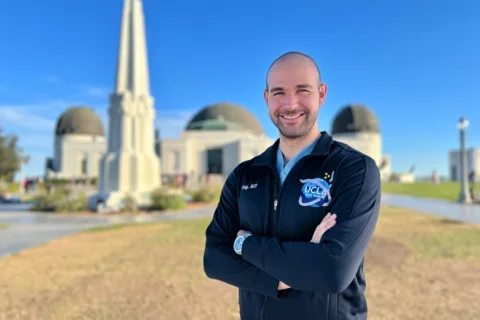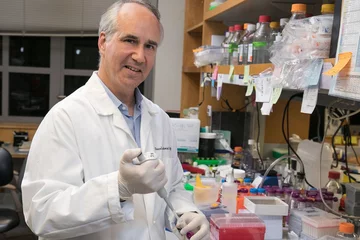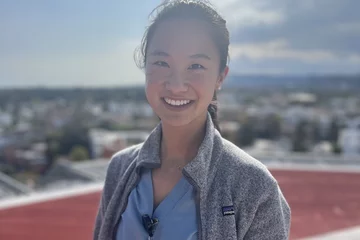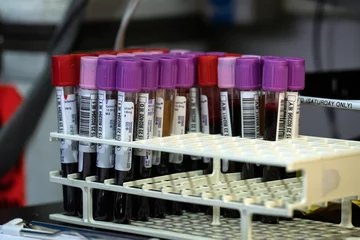As a space medicine fellow, Dr Haig Aintablian will work with both the public and private space industry, learning additional skills such as engineering, bioastronautics and space physiology.
UCLA’s Dr. Haig Aintablian, campus’s first space medicine fellow, will have a role in shaping the next generation of flight physicians
When William Shatner found himself 65.8 miles above a Texas desert in a hydrogen-fueled rocket last year, he didn’t have to worry about blinding flattening in the back of his eyes, fluid shifting from his abdomen to his face or the chance that his heart might change shape.
However, had his stint in weightlessness been seven months long, like future missions to Mars would be, instead of just three or four minutes, he may have wanted a UCLA’s Dr. Haig Aintablian next to him. Aintablian isn't just a doctor, he is UCLA’s inaugural fellow in space medicine.
“When this opportunity came up to build a fellowship with our partners in the space industry, I felt like my life just became complete,” said Aintablian, who has been a space fanatic since seeing Saturn’s rings through a telescope with his dad when he was 7.
With the uncrewed Artemis moon mission scheduled for liftoff in November and hopes for a mission to Mars to follow in 10 to 20 years, the fellowship couldn’t have come at a more pressing time, Aintablian said.
“We've done a lot already here on Earth. In fact, we might have done too much,” he said. “The next step is to become interplanetary.”
As a fellow, Aintablian will work with both the public and private space industry, learning additional skills such as engineering, bioastronautics and space physiology.
Ultimately, Aintablian hopes that one day he’ll be suiting up on a trip to Mars and caring for the astronauts during the roughly 140-million-mile flight. When he does, he’ll be carrying the UCLA name to crewed space travel’s farthest reaches yet.
Providing medical care for people in an off-campus setting has been part of Aintablian’s UCLA experience. As a medical resident, he started a service providing house calls to individuals and has been involved with the Mobile Clinic Project at UCLA, a volunteer group of clinicians giving medical care to individuals experiencing homelessness, and to other vulnerable populations in the greater Los Angeles area.
In addition, the Glendale, California, native has joined UCLA alumni to offer free tattoo removal services to formally incarcerated individuals in downtown Los Angeles.
Practicing medicine in space seems like the obvious next step for Aintablian, a self-identifying “adrenaline junkie” who is part of a new campaign that will be recognizing UCLA’s presence in the community and beyond.
“The purpose of our fellowship is to establish the next generation of flight surgeons who would help with these planetary expeditions as well as with crewed space travel of normal human beings,” said Aintablian, who wants to see different kinds of people going to space for extended periods, not just professional astronauts.
Aintablian says that there’s a lot of things that can happen to the body in space, even in the comfort of a vessel protecting those aboard from the vacuum of space and freezing cold temperatures.
Astronauts who have been in microgravity environments for as little as a few weeks have shown signs of spaceflight-associated neuro-ocular syndrome, which is vision loss due to what scientists think is fluid shifts causing dilatation in certain areas behind the eye and in the head, Aintablian said.
Another possible negative side effect of prolonged space travel is a condition dubbed “space face,” in which blood that normally settles in the lower parts of the body due to gravity, instead becomes free-floating in the body, causing one’s face to get puffy.
Aintablian lists other space-related pathologies that are in early stages of being understood, such as chronic radiation exposure from cosmic rays and solar flares, changes in the heart that occur due to the changes in pressure needed to pump blood across the body and poor immune system functionality due to changes in immune cells and enhanced bacterial toxicities.
To prepare for the possibilities of these ailments and others, Aintablian and those who follow in the UCLA fellowship will undergo a mission in Utah that mimics the conditions and health risks space travelers would face on the surface of Mars and will conduct research with public space industries. They will also participate in rotations in an isolated polar environment with limited resources to understand how the body withstands physiological changes in such terrains.
“The program is designed to produce doctors who could do virtually anything, doctors who can act like a Swiss army knife in space,” said Aintablian, who completed an emergency medicine residency at the David Geffen School of Medicine at UCLA in July and has remained an emergency physician while taking part in the fellowship.
“I'm really thankful for these opportunities, and I'm excited to see what the future holds.”
Original Article: "Space medicine: Future interplanetary travel will depend on it"




